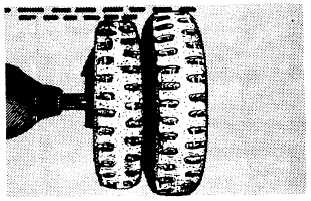Figure 3-14.—Mismatched tires
keeps dirt and moisture out of the valve body. The
screwdriver cap has a forked tip that may be used to
install or remove the valve core. The plain cap generally
is used on rubber-covered valves and has a skirt that
contacts the rubber covering on the valve stem. Both
caps are interchangeable with each other. Part of your
prestart operation is making sure that all valve stems
have valve caps.
Mismatching
For longer tire life and more efficient performance,
dual tires and tires on all-wheel drive vehicles must be
of the same size, tread design, and tread wear.
Improperly matched tires cause rapid uneven wear and
can also cause transfer case and differential failures.
Accurate matching of tires is necessary, because
tires on axle-drive vehicles rotate at the same speed
when all axles are engaged. Dual wheels turn at the same
speed, because they are locked together which means
that tires on all driving wheels must be of the same
circumference and diameter. When one tire of a pair of
duals is worn considerably more than the other, the tire
cannot carry its proper share of the load and will scrub
the road (fig. 3-14). The result is uneven and rapid wear
on both tires and/or tire failure.
Tires should be used in sets. Mixing different types
(bias ply, fiber glass belted, radial ply) must be avoided.
Snow tires should be of the same size and type of
construction as the front tires. Radial-ply tires should
always be used in sets.
NOTE: Under no circumstances should radial-ply
tires be mixed with bias-ply tires, together or on the
same axle.
The problems encountered when mixing tires on a
vehicle are loss of steering control, inadequate vehicle
handling, and potential mechanical damage. These
problems vary depending on the stability of the tires
used, differences in dimensions, differences in air
pressure, and other operating conditions.
RADIAL-PLY TIRES.— Radial-ply tires (fig. 3-15)
are constructed with casing plies perpendicular to the
tread direction, with several layers of tread-reinforcing
plies (steel or fabric) just under the tread area. This
construction permits flexing of the tire with a minimum
of tread distortion, better traction, and a softer ride.
Figure 3-15.—Radial-ply tire construction.
3-9



